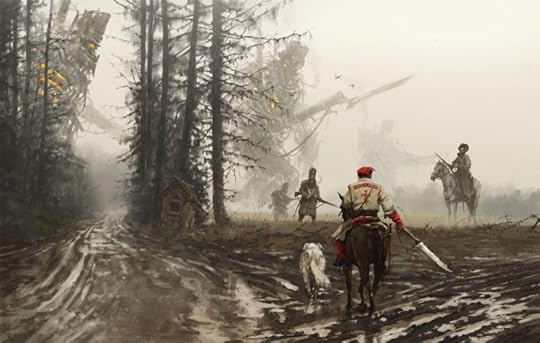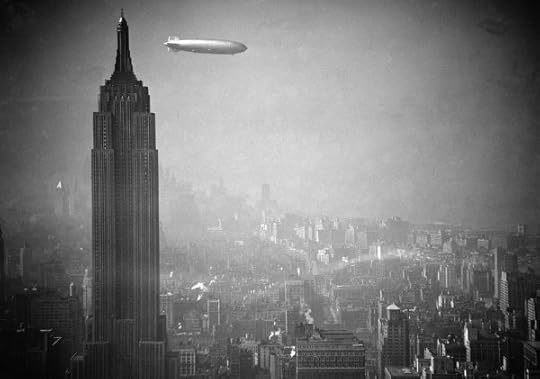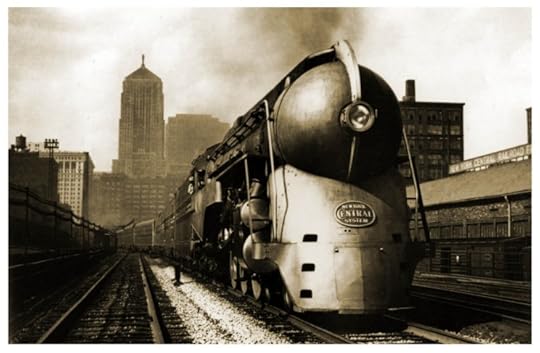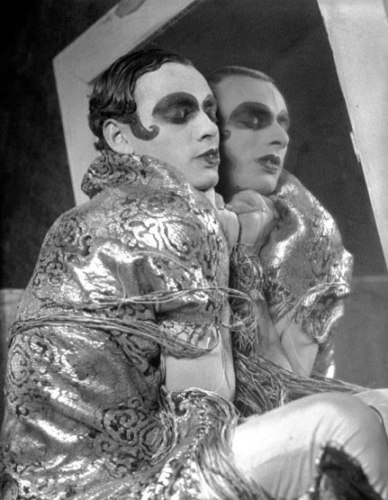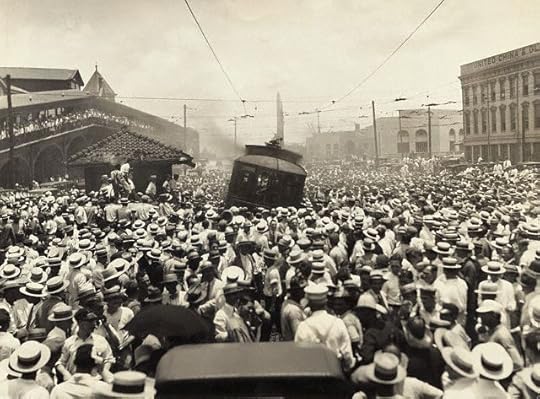Sarah Zama's Blog, page 56
March 2, 2017
Thursday Quotables – The Ghost of the Rath
After a few intolerable moments I felt better, but the heavy air pressed on me stiflingly and I rushed from the inner room into the larger and outer chamber. Here a blast of cool air revived me, and I saw that the place was changed.
A dozen other candelabra besides those I had lighted were flaming round the walls, the hearth was all ruddy with a blazing fire, everything that had been dim was bright, the luster had returned to the gilding, the flowers bloomed in the vases. A lady was sitting before the hearth in a low armchair. Her light loose gown swept about her on the carpet, her black hair fell around her to her knees, and into it her hands were thrust as she leaned her forehead upon them, and starred between them into the fire. I had scarcely time to observe her attitude when she turned her head quickly towards me, and I recognized the handsome face of the magnificent lady who had plaid such a sinister part in the strange scenes that had been enacted before me two nights ago. I saw something dark looming behind her chair, but I thought it was only her shadow thrown backward by the fire.
She arose and came to meet me, and I recoiled from her. There was something horridly fixed and hollow in her gaze, and filmy in the stirring of her garments. The shadow, as she moved, grew more firm and distinct in outline, and followed her like a servant where she went.
 The Ghost of the Rath by Rosa Mulholland in part of the Twelve Irish Ghost Stories anthology and was first published in 1891. It’s a very classic gothic story, with an abandoned, gloomy manor and a secret history with a murder. But I find it very evocative, especially in the atmosphere. The place is more vivid then the characters and not only where it becomes alive with the shades of people who lived and died there.
The Ghost of the Rath by Rosa Mulholland in part of the Twelve Irish Ghost Stories anthology and was first published in 1891. It’s a very classic gothic story, with an abandoned, gloomy manor and a secret history with a murder. But I find it very evocative, especially in the atmosphere. The place is more vivid then the characters and not only where it becomes alive with the shades of people who lived and died there.
Descriptions are so vivid and visual that it almost feels like you stand there, right beside the characters. This is what I like about classic gothic fiction. Today, many readers seem to think that descriptions are boring and that action should be favoured, but I think that when done well, description can created a new world we can visit as reader.
This story sure does the trick.
—————————————————
In post is part of the Thursday Quotables meme. If you want to discover more about this meme and maybe take part in it, head over to Bookshelf Fantasies
 This post is also part of the Ireland Reading Month organised by 746 Books and The Fluff Is Raging blogs.
This post is also part of the Ireland Reading Month organised by 746 Books and The Fluff Is Raging blogs.
“Last year we hosted a whopping 130 posts on all things relating to Irish culture. Books, food, travel, movies, theatre and favourite bookshops – your enthusiasm was boundless and so was your reading.
So this year we hope to be bigger and better.
To celebrate the wealth and breadth and general awesomeness of Irish cultural life, 746 Books and Raging Fluff are co-hosting a month long celebration of all things Irish.”
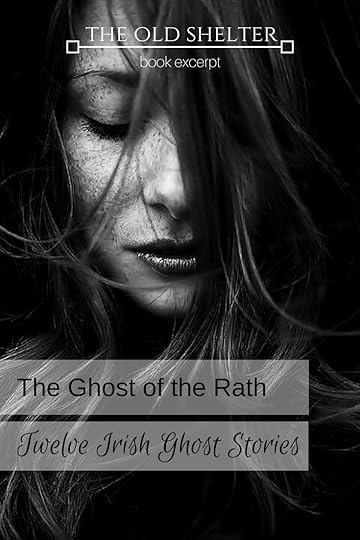
The post Thursday Quotables – The Ghost of the Rath appeared first on The Old Shelter.
February 23, 2017
Thursday Quotables – The Green Mill Murder (Miss Fisher Misteries)
‘Charles, dear, do stop asking unanswerable questions and pay attention. What about the murder of Bernard? Did you know him?’
‘Yes.’
‘And you knew that he had incriminating photographs of you?’
‘Yes.’ Charles took a cigarette from the box on the table and lit it with a jazz-striped lighter.
‘And you were at the Green Mill to watch him take part in that ghastly dance marathon?’
‘Yes. Mother was nagging at me to go out with you and I thought that as long as I had to go, I might has well see Bernard in the marathon and watch him break a leg, with any luck. But I never have any luck. If someone was going to kill him, and there must have been hundreds of people who wanted him dead as much as I did, why did they have to choose the night I was there? It looks bad, doesn’t it?’
‘Yes. But there are points in your favoure. One is the fact that you fainted at the sight of blood. The other is the weapon. It still hasn’t been found.’
‘Did they search all those musicians?’
‘Yes.’
‘Because they were all over the body like a rash. Tintagel Stone and Ben.’
‘Yes, but neither had any weapon to kill Bernard. Also, they only came down to see what had happened after he fell, and he was dead when he hit the ground.’
‘They’ll hang me, won’t they? The hangman will come up in a mask and put a bag over my head and a moose around my neck and they’ll kill me, they’ll kill me!’
Charles’ voice had risen to a scream. Phryne slapped him, hard, across the cheek. He gaped at her.
‘You hit me!’ he gasped. ‘ You hit me!’
‘And I’ll hit you again if you don’t pipe down. You’ll rouse the house. You have overlooked the factor that is going to preserve your miserable life.’
‘What?’ asked Charles, hand still capping his reddened cheek.
‘Me,’ said Phryne immodestly. ‘I am a vital factor. I will find out what happened and I will get you out.’

I first came in contact with Miss Phryne through the tv series. I don’t know why, I had a feeling it was going to be a silly show, but since it’s the 1920s and since it’s mystery, I decided to give it a go. I fell in love.
So when I got the chance to read one of the books through NetGalley, I immediately grabbed it. Once again, I was initially put off (it wasn’t the first book in the series and at the beginning I had a hard time getting into it), but then a fell in love all over again.
There is really a lot to love about this series. First of all, Miss Phryne Fisher is a fantastic character: haughty and elegant, but also good-hearted and generous. Clever, educated, self-confident, but also insecure enough to make her not really a superhero.
The cast of characters around her is equally endearing, very easy to love all of them in their own way. This was a huge winning point for me.
The era reconstruction is absolutely outstanding, one of the best I’ve read. It is plain clear this author did a lot of research and – this is the tricky part – integrated them into the story seamlessly. Greenwood’s 1920s world is vivid, real, and still different enough that you know it is not the world we’re living now. Still she depicts it in such natural tones you can’t help feel you’re there.
The mystery was clever and well constructed as well as the investigation. I even like the romantic parenthesis Phryne takes at some point, though that went on for a little bit too long for me (but hey, I’m not particularly fond of romances, so…). I really liked the connection with WWI, which – like all the rest – was integrated beautifully in the story.
It’s a great series. Read it!
—————————————–
In post is part of the Thursday Quotables mem. If you want to discover more about this meme and maybe take part in it, head over to Bookshelf Fantasies
[image error]
The post Thursday Quotables – The Green Mill Murder (Miss Fisher Misteries) appeared first on The Old Shelter.
February 14, 2017
The Freedom to Choose – Courtship in the 1920s
I dare you to try: google for ‘flapper’ or ‘courtship in the 1920s’ and you’ll probably find a lot of articles online that praise the freedom gals found in the Jazz Age with regard to their sexuality and their desires. Even worst, if you search books set in the 1920s, you’ll find a whole host of stories telling the erotic exploits of young flappers.
Mhm… I’m not saying courtship and sexual life didn’t change hugely in the 1920s, especially for women. Sure it did. But the ways and the magnitude is often misunderstood by the casual reader. When we speak of sexual liberation, we should always remember that what they meant back then isn’t necessarily what we mean today.
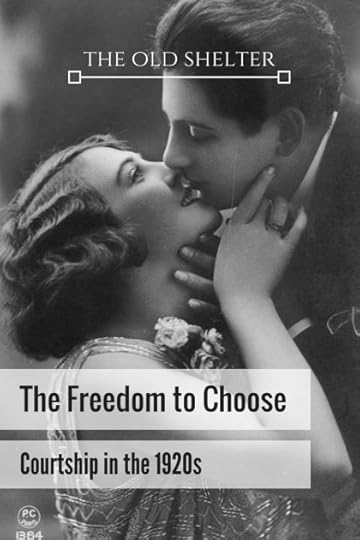
Victorian Courtship
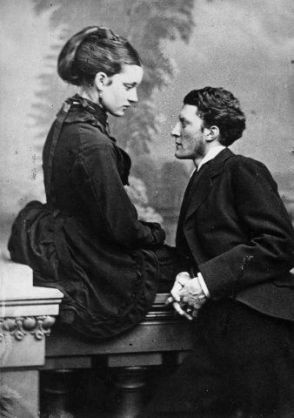 To properly understand the change, we have to take a look at where 1920s young people came from.
To properly understand the change, we have to take a look at where 1920s young people came from.
Up until the 1910s, courtship was a very complex ritual, that concerned not only the lives of the two people involved in the marriage, but also a host of family considerations, with regards to economic, political and social aspects. Although romantic considerations had started entering the matter of who a young person would marry, marriage was still widely a family affair and so courtship mostly took place in the home.
A young man would be encouraged to ‘call’ on a young woman. He could of course refuse to call, but if he did, he entered the woman’s space. He would meet her parents, he would talk to her in the family parlour and maybe be offered refreshment and entertainment by her in the form of piano playing and singing.
Basically, it was a family matter to create the conditions for a young man to be able to ‘call’ on the girl, and for the girl to be able to receive the man.
This social ritual, originating with the upper class, common between the middle classes and copied as far as possible by families of more modest means, gave the girl and her watchful parents a strong control over the process.
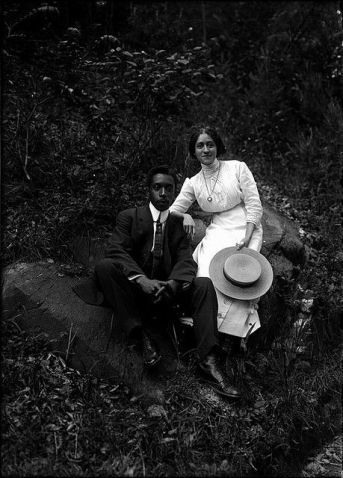 By the early XX century, social conditions have changed to the point that ‘dating’ started to replace ‘calling’.
By the early XX century, social conditions have changed to the point that ‘dating’ started to replace ‘calling’.
Many families had moved to suburban residences, which tended to be smaller than in the past and had less space for receiving and entertaining guests. At the same time, cities had started offering multiple modes of entertainments, from theatres, to dance halls, to movies. It was also easier for people to move comfortably around because of the car becoming increasingly more common.
Although courtship was still a family matter, courting couples began to go on dates, prearranged excursions to soda and coffee bars or movie theatres. Places away from the house where the young couple, even in the midst of a crowd, still experienced less supervision and more privacy than in the parlour.
Furthermore, the car became itself a place of intimacy, and since the man was far more likely to own and use one, it was now the woman that entered the man’s space, which gave the man slightly more control over the courtship process.
Jazz Age Courtship
By the 1920s, two social shifts that were huge by their own right had occurred in Western society:
1. Thanks to the more readily available and widely accepted methods of contraception, the family had become a place of affection and companionship more than need. This had especially impacted the lives and expectations of the children, who had been further encourage to find a partner who would be a good match for the person’s life aspirations.
2. More and more young people attended college, both young men and women. This placed them in a freer environment, away from the traditional places of supervision. In this new environment, young people developed their own social rituals and their own values, depending on their own desires and aspiration more than those of their elders.
In fact, it was in colleges that the youth culture found its more important expression and here it is where the new courtship rituals became more prominent and accepted.
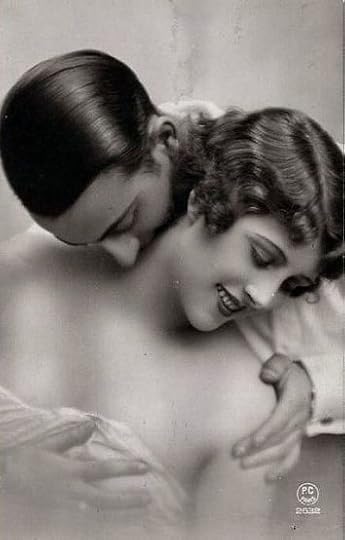 Dating
Dating
In the 1920s, dating had become commonplace. Young people now had unlimited possibility to meet at social events at dance halls, speakeasies and bars, skating rinks, movie theatres, sports courts, places where man and women could freely mixed in a socially acceptable environment. In these conditions, dating ceased to be specifically a search for a mate and became a means for casual social entertainment.
In colleges and high schools, where the practice spread, dating came to be regarded as a means to demonstrate popularity. The more numerous and varied the dates, the higher one’s status. For many young people, dating was a form of recreation and self-affirmation, not necessarily a true courtship of a potential life companion. Dating permitted a paired relationship without implying a commitment to marriage and so it encouraged experimental relations.
Petting and necking
Petting and necking described a broad range of potentially erotic physical contacts, from casual kisses to more intimate caresses and fondling (the distinction depending on whether the contact was above or below the shoulders). It became widely practiced especially by young people, a perfectly acceptable expression of affection in a couple.
In the 1920s, young people's behaviour toward courtship changed hugely #love
Click To Tweet
What were the limits?
All of this looked like huge freedom to the adults, who started to fear for a life of promiscuity for their children. But if young people in the 1920s did have a lot more freedom in term of choosing a partner and exploring that relationship then their parents had, they still had limits that the adults sometimes failed to see and that were held in place by the peer group itself.
This generation developed a sexual behaviour that was a middle ground between the no-sex-at-all taboo of their parents and their own interests and marital aspirations. They laid the basis for the huge change in the accepted standard. But with all their freedom, these youths were still influenced by their childhood training as well and the more immediate control and sanction of their peers.
[image error]Although the peer group accepted and even encouraged the practices of dating and petting, these activities were considered acceptable if devoted to one person, and if that person was the one who would likely become a life partner. Even premarital intercourse, which became increasingly common as the contraception methods became more efficient, was acceptable only when it happened with the chosen partner, the one the person was going to marry. Intercourse with a casual partner, which was horrifying to their elders, was still strongly sanctioned even by peers. Although gender distinctions and sexual attitude were beginning to change, most of the sexual activity that did take place was only with a single partner whom the individual expected to marry.
In any case, the ‘double standard’ was still in place and very strong. It was generally acknowledged that a young male could not be expected to be faithful to a single companion and he would explore and experiment, but a woman who behaved in the same way was considered to have abandoned her virtue. In fact, giving in to a man before marriage was always dangerous for a woman. Even if she had a steady relationship (or what appeared to be a steady relationship) and she gave herself to that man, if the relationship then failed and she married a different man, the social consequences and sanctions of her act would still fall over her.
So, in spite of new attitude and behaviour that were certainly new and freer, the fundamental aspiration and expectations of young people weren’t all that different from their parents’. They were enacting a social revolution – something that the Great Depression and then WWII would stopped and prevent evolving until as far as the 1960s – it just wasn’t as radical as we love to think.
———————————————-
READ MORE ABOUT IT
Fass, Paula S., The Damned and the Beautiful. American Youth in the 1920s. Oxford University Press, New York, 1977
Kyvig, David E., Daily Life in the United States 1920-1940. How Americans Lived Through the ‘Roaring Twenties’ and the Great Depression. Ivan R. Dee Publisher, Chicago, 2002
Vintage Treasures – My Victorian Valentine
Davies Linguistics – Love, romance, and “wild women” in the 1920s
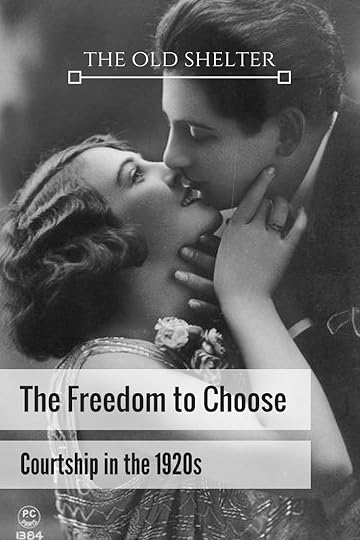
The post The Freedom to Choose – Courtship in the 1920s appeared first on The Old Shelter.
February 9, 2017
Thursday Quotables – Renting Silence
The faint sound of the approaching engine grew steadily louder until it drowned out the fierce pounding of my heart. I had to time my move carefully so I could jump on to the moving ladder and hold on. Closer to the station would be slower and easier, but too close and they’d see me. Too far back and the speed would wrench my hand from the railing and knock me down. I would only get one chance.
The train roared in, brackets squealing as it neared the station. Closer and closer. The moment the engine passed me, blocking me from the sight of anyone standing on the platform, I came out from the steel barrels and started running. The noise was deafening. Wheels screeched against the track, cylinders pounded, steam hissed. The brass bell clanged to signal arrival.
There was no time to think at the very real danger to losing my balance and falling under the wheels. A ladder on a passenger car went by, but I had to let it go. Too fast. The second car could be my last chance – I couldn’t count on there being a third passenger car – so I threw myself on to its ladder, left foot and left hand at the same time. The speed nearly tore my arm from its socket and the whiplash slammed my head against the side of the car, but I reached for the other railing with my right hand and, dazed, pulled myself up the steps. The brackets hissed in protest and moved slower with every second. The acrid odor of the stream cloud engulfed me. On my knees, then on my feet, I climbed the steps and wedged myself into the vestibule between the two cars.

Renting Silence by Mary Maley is part of an ongoing mystery series set during Hollywood silent era. This is the first novel I read in the series (though it’s actually the third in the chronology) and I have to admit, I have contrasting feelings about it.
I really liked the setting, especially when it came to the central part, all set in the vaudeville world. It’s pretty obvious that the author made lots of the research and she depicts a vivid world, where real people live real situations.
Instead I’m not sure how I feel about the author using so many real life people in the story, all related in some way to the main character. Mary Pickford, Douglas Fairbanks, Bob Hope, Myrna Loy and others, all find place in the life of this one character. I’m not particularly keen on the fictional use of real historical people in general, and when they crowd like this…
I’m also particularly wary about some social attitudes: in some instances, these characters sounded and acted too modern for the time period (in my opinion).
The mystery is very good. I think it was clever, one of the best I’ve read lately. That really sounded grounded in the time and place and I liked this. I’m less fond of the way the investigation was conducted. There are places where the getting of information is a bit forced – others when it’s so natural you barely realised you’re given a clue (I love this!). But what really bothered me was the way things which are completely disconnected with the mystery get in the way on occasions, particularly the very long closing episode where, just before the reveal of the mystery, you get several chapters of a train robbery which has zero connection to the main plot.
All in all, I liked the book. It’s easy to read, the characters are easy to love, the mystery is clever. Not an unconditional love, but sure a lot of enjoyment.
—————————————–
In post is part of the Thursday Quotables mem. If you want to discover more about this meme and maybe take part in it, head over to Bookshelf Fantasies
[image error]
The post Thursday Quotables – Renting Silence appeared first on The Old Shelter.
February 4, 2017
Gang Roundup – February 2017
Had a lot of fun with the Gang Roundup in January, guys! Lot’s a good posts to share. I have to warn you that this roundup leans dangerously on the dieselpunk sid, but I do have a few historical posts that I really love.
Hope you’ll enjoy them as much as I did.
Bizarre Paintings Of Mecha Robots And Werewolves Attacking East European Peasants Of The Early 20th Century
I find retrofuturistic illustrations absolutely fascinating. I love the mix of history and fantasy, that sense of displacement that isn’t scary, but reveals something new. I find it exciting.
I discovered the work of Polish artist Jakub Rozalski completely by chance and fell in love right away. Don’t you think it’s absolutely amazing?
The World of Scythe is a beautiful 105-page art book showcasing the work of Jakub Rozalski for the board game Scythe, one of the most successful games ever funded on Kickstarter. The book was only made available to backers during the Kickstarter campaign, and is now only available on ArtStation Shop.
 Iron Harvest
Iron HarvestJakub Rozalski also created the setting for for the RPG game Iron Harvest, set in a dieselpunk 1920s East Europe-like world.
1920+ is an alternate version of our own world created by Polish artist Jakub Różalski. In the early 20th century, tradition clashes with progress, and the world is still full of mysteries and secrets.
Dieselpunk Lexicon
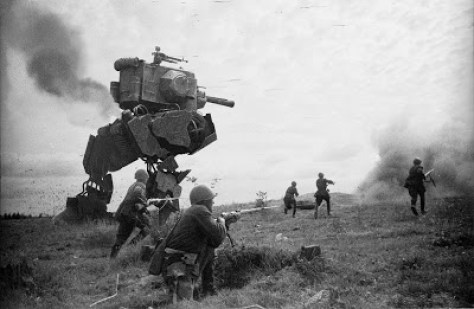
I’m really enjoying Larry Amyett‘s series about the keywords of Dieselpunk. This month, both his posts were concerned with the ‘era’ of Dieselpunk
Dieselpunk Lexicon Part 8: Diesel Era
The most accepted definition of the Diesel Era is that it lasted roughly from the 1920s to the 1950s, although some dieselpunks (like myself) include both World Wars and see the second half of the 1950s as already out of it.
As with most genres, there isn’t a very definite border, besides creatives of all inclinations will always try to blur those borders. As it should be.
Dieselpunk Lexicon Part 8: Interbellum Period
“The Interbellum Period had clear starting and ending dates. It began on November 11, 1918, which the day the Armistice went in effect and hostilities stopped in World War One, and ended on September 1, 1939 when Germany invaded Poland.”
While both World Wars are very popular with dieselpunk authors, the Interbellum Period, particularly the last stretch nearest to WWII, is also very popular because it echoes of a defining characteristic of dieselpunk: the noir mood.
Many dieselpunk stories are drenched in noir mood and they envision a world that is very easily seen in the Golden Age of Hollywood film noir, the 1940s.
Surviving the 1930s
For a lucky coincidence, Tome Wilson also spoke about the Diesel Era on The Gatehouse website. This is a fascinating excursus on the historical period, with a particular enphasis on everything that Dieselpunk has gladly adopted as its own.
If the 1920s were a time of excitment, in good and bad, and the 1940s were a dark age inesorably falling into global war, the 1930s were a time in between where the preceeding and following era merged and collided.
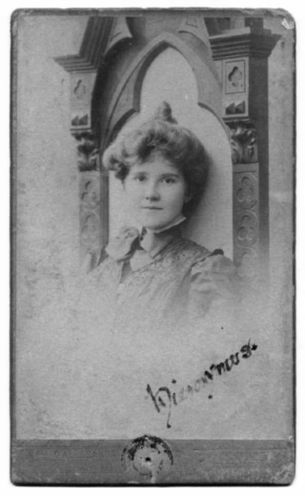 With Copper, Foil, and Paint, a Little-Known American Sculptor Saved Scores of World War I Soldiers from a Faceless Future
With Copper, Foil, and Paint, a Little-Known American Sculptor Saved Scores of World War I Soldiers from a Faceless FutureI’m always surprised about how little we actually know about WWI. Because of how terrible WWII was, we generally tend to forget about the Great War which preceded it of just one generation, but WWI was truly a devastating experience for the generation of young men and women who were involved (and not just them).
It was a war that made millions of dead and that damaged permanelty (both in body and mind) millions of other.
One of the worst wounds that plagued those veterans of WWI were facial disfigurements. We never think about it because then surgery advanced so much that this was less of an issue in later years. But many young men came back from the war with their faces completely destroyed. I’ve seen photos that truely made me wonder how those poor men could even be still alive, with entire pieces of their face gone.
I can only imagine what it may have mean to live the rest of their life with such a face.
An American artist, Anna Coleman Ladd, took it upon herself to do something for these people. She created delicate masks that recreated the whole face of the injured and that could be disguised on the person’s face with makeup.
It’s an incredible story, one of the many that we don’t know about WWI.
Good Night, Angela and Flappers & Jelly Beans
Although in this post author Delynn Royer technically launches her book Good Night, Angela, she also tells of a fascinating place I didn’t even know excisted: the 20th Century Limited. This was an American luxury train, not very different from the European Oriental Express, that travelled from New York City to Chicago. You can see it in the ebove photo… which I have to tell you, is among the most popular photos I’ve ever spotted in the dieselpunk community.
It was nice to learn its history.
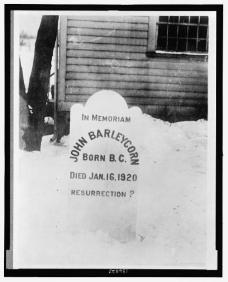 John Barleycorn Must Die: Today in History, Mock Funerals Took Place Across America as Prohibition Began in Earnest
John Barleycorn Must Die: Today in History, Mock Funerals Took Place Across America as Prohibition Began in Earnest“On January 17th, 1920, hundreds of fake funerals were held in churches and bars across the country for a man that didn’t exist. John Barleycorn, the anthropomorphic personification of beer and whiskey, was symbolically laid to rest amid cheers and tears at 12:01 AM, January 16th, 1920. These mock funerals saw the actual burial of a bottle effigy, complete with pomp and circumstance. The tone of the ceremony varied widely, however, depending on who was conducting the funeral rites.”
I’ve always found this part of Prohibition funny. Although I’ve read about it in many book and articles, this is the first time that I read about it in details.
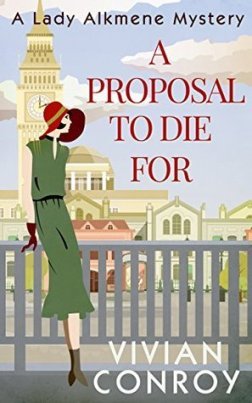 A Proposal to Die For
A Proposal to Die ForThe opening scene of A Proposal to Die For came to me in a flash: a lady in evening dress reaching for a golden lighter on a mantelpiece to relight her cigarette and then overhearing a few whispered words coming from behind an opulent Chinese silk screen. A marriage proposal, but in the same breath a reference to someone who would be better dead if the marriage is to work out.
I don’t know about you, but that’s an image that really really intrigues me. So this book goes straight in my TBR list, which is growing allarmingly long (and very much 1920s!) lately.
I met Vivian Conroy on Twitter Where she’s a lively animator of the #WritersWise chats. Do come along next time. It’s fun.
Just Some Moves
And finally, something that is really only just fun.
Just Some Moves is a Düsseldorf native dancer who has become very popular on the net with his reinvention of dancing moves that – in my opinion – have a lot of the jazz/swing era.
He’s featured in an Italian commercial, that’s how I discovered him. Then I learned of his first commercial for a German company.
Have a look, he’s fantastic!

The post Gang Roundup – February 2017 appeared first on The Old Shelter.
January 27, 2017
International Holocaust Remembrance Day 2017
Last May I helped in the organization of a book festival here in the province of Verona, and I had the opportunity to take part to a very special event: Ennio Trivellin’s conference, who’s a survivor of Mauthausen concentration camp.
Ennio Trivellin isn’t a Jew. He was interned in the concentration camp because of his political activity in Verona. But I’d like to speak about what he told us that night because he’s still a living memory of what happened in those places.
He spoke for almost three hours to a conference hall packed full of people, here I’ll just report what I remember most clearly. Let me tell you, it was horrible to hear, especially from someone who lived it, but I’m grateful I had this opportunity at least once in my life.
Life and death in Gusen concentration camp
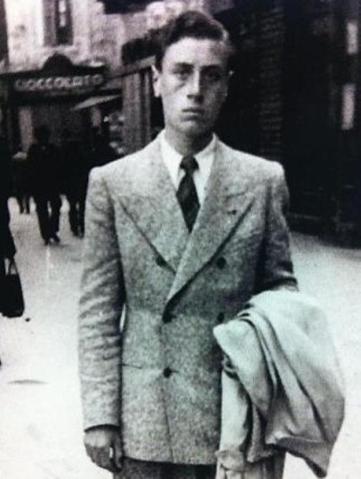
Ennio Trivellin in 1944
In 1944, when Ennio was arrested with his father by the SS, he was 16. He was sent first to Mauthausen, then in Gusen concentration camp, which was at a walking distance from Mauthausen and where he would spend seven months before the war ended and all the prisoners were freed.
He said the concentration camp was a factory. The Nazis built aircrafts there, basically at no cost because they exploited the prisoners’ work as long as they could, and when the prisoners could no longer work, they just got rid of them and replaced them with new prisoners.
Prisoners would work all though the day with just one break of 20 minutes at lunch. They would eat a stew of turnip, standing in a line in front of the cauldron, and gulping down as quick as they could, so that everyone in the line could eat. Because when the time was up, the food would disappeared and if you hadn’t eaten, you just had to way the day after.
Ennio said they were constantly starving to a point that the hunger drove them mad. To try and quench it, many prisoners (him included) would eat pieces of bricks. “I don’t know what else this does to a person’s stomach,” he said. “But it does quench the sense of hunger.”
All prisoners were particularly horrified by the hospital. If you got into the camp hospital, it was nearly guaranteed that you wouldn’t get out. Ennio did ended up there once, because of a fever. He was laid in a bad with another man and left there. Luckily, he got though the fever and survived. Not so the man in the same bed. When Ennio realized the other man was dead, he started pushing him off the bed with all the strength he had. He had no sadness or feelings for that corpse, he just wanted to be rid of it.
Human beings
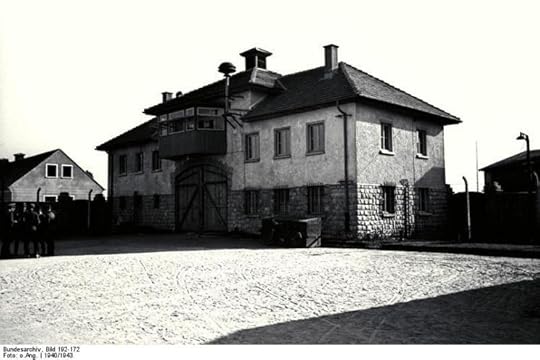
Gusen Concentration Camp
“You have to understand this,” he told us. “When you are in such dire circumstances, you stop thinking, feeling, acting as you normally do.”
You become an idiot (that’s exactly the word he used: idiot). You don’t care for anything and anyone other than yourself, because the only thought you have is: I must survive, I must survive, I must survive, whatever it takes. You’re not afraid of doing anything that might be of any use, and you don’t fear the consequences as long as it allows you to go on. You don’t feel for the others’ sufferings, because you are concentrated on not getting into the same sufferings. You kind of get into an alternate reality where you mind conjures up anything that can allow you to survive and molds the reality around you and your values so that it will more likely get you thought it all.
It was chilling to hear.
“Many people ask me whether, young as I was, I wasn’t afraid of death all around me.”
Your sense of death changes completely. Ennio said he – as everyone else around him – saw hundreds of corpses in the camp, but nobody felt for them. They didn’t feel those were dead people. They were just things and you don’t feel for things.
It went to the point that when the Allies finally arrived and liberated the camp, they gathered the dead and asked the survivors to identified whoever they could.
“None of us could say any name. The dead we saw were things, not the people we had known. In our minds, the people we knew looked like the first time they arrived to the camp. They didn’t look anything like the skeletal corpses we now saw and so of course we could not identify them.”

Mauthausen Concentration Camp
Life and remembrance
Days after, I talked about the experience with my boss, Lara. I told her I has grateful for being there that night. Ennio Trivellin said only six survivors still live in Verona, and he is the only one well enough to still go around giving testimony. Lara told me, “We are indeed still lucky we can hear that testimony from the very people who lived it. Soon there won’t be any of them left. What will be then of that memory?”
But this is life, isn’t it? No one lives forever. It will always come a day where all the witnesses will be gone. But memory endures. If we remember and we share, the memory will live on far longer that the people who was there, and remembering will make us better persons.
If we don’t remember, we may do the same mistakes over and over again, and more people will suffer. It doesn’t const us anything, to remember and to share. Everyone of us can offer a little shards to pass down and let the memory leave on.
And so I try to do. I’m passing on what I heard that night.
——————————————————-
About the Holocaust and the United Nations Outreach Programme
Il racconto di Ennio Trivellin, partigiano veronese deportato nel campo di sterminio di Mauthausen – StoriaStorie
A Gusen solo orrori, avevo perduto la mia dignità – Veja.it
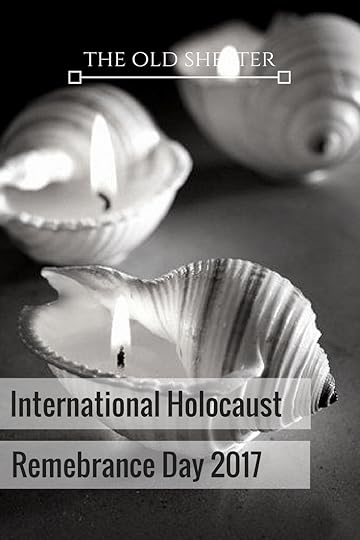
The post International Holocaust Remembrance Day 2017 appeared first on The Old Shelter.
January 16, 2017
Martin Luther King Day 2017 – Faith
– Martin Luther King, jr

The post Martin Luther King Day 2017 – Faith appeared first on The Old Shelter.
January 12, 2017
Thursday Quotables – Get Me to the Grave in Time
Beyond the shade garden, the church graveyard stone crosses and headstones marched in straight rows. A man and woman stood there in conversation.
“I believe that’s the groom.” Having met Ambrose Farrow several times, Eliza recognized his dark blond hair and mustache. “But I don’t know who the woman is.”
“Her name is Pearl Palmer.” Mrs. Higgins’s voice had grown chilly.
“Sounds like a strange name,” Higgins said. “Is she an actress?”
Eliza, who loved to spend her free time at the cinema and music hall, failed to recall seeing that name on any theatre program. “I’ve never heard of her.”
His mother narrowed her eyes at the couple, who seemed to be engaged in a heated discussion. Both of them were waving their arms about. “She’s a mannequin.”
Pickering chuckled. “She looks alive to me.”
“A mannequin models clothes at the more expensive salons,” Eliza explained.
“Miss Palmer is far more than that,” Mrs. Higgins said. “She is Ambrose Farrow’s mistress.”
“What?” Eliza, Higgins and Pickering all explained at the same time.
“Keep your voices down,” the old woman said in warning. “If you wish to watch people unobserved, the first requirement is to avoid being noticed.”
“Ma’am, how did you learned Mr. Farrow has a mistress?” Eliza whispered.
“After Minerva became engaged,, I made a few discreet inquiries. And too many people said the same thing. Ambrose Farrow and Pearl Palmer are lover.”
“Does the Duchess know?” Pickering asked Mrs. Higgins.
“Minerva is a woman of the world. It would not surprise me if she knew.”
“And she’d still marry him?” Eliza wasn’t a woman of the world and found this shocking.
 Get Me to the Grave in Time is a cosy mystery by D.E. Ireland, set in London in the 1910s and inspired by the play My Fair Lady. The main characters are in fact the same of the play, which I found a nice idea… thought I can’t say anything about the ‘translation’ since I’ve never seen the play.
Get Me to the Grave in Time is a cosy mystery by D.E. Ireland, set in London in the 1910s and inspired by the play My Fair Lady. The main characters are in fact the same of the play, which I found a nice idea… thought I can’t say anything about the ‘translation’ since I’ve never seen the play.
I really like the setting, it’s quite vivid and it sounds accurate, if a bit too much upper-class for me. The authors spend a great deal of time describing all the wonderful things these characters have access to, especially considering that most of them are very rich and often nobles. But apart from this (which is totally just me), the cast of characters is very nice. Everybody is likable – expect the ones you’re not supposed to like – and I really enjoyed the dialogues – fresh, natural and witty -which I find to be the authors’ strong spot. The banters between characters is the element that I enjoyed the most.
The mystery, instead, was quite disappointing. Yes, it is exciting while reading because something is happening all the time, but once the story ceases relying on action and must come to explanations… well, things fall apart quite apparently.
First, events become not as logical as they should be, and I felt this happened because the authors needed to force a few elements into the plot so to move it the direction they needed. There are a couple of chapters clearly falling into this categry. Secondly, the characters’ reasons – and I mean the reasons of the characters who act the mystery – are never very clear. I found the murder’s reasons particularly lame, certainly not strong enough to push a person to kill another person… let alone more than one.
This gave me the impression that while the authors are very comfortable telling about the cosy side of the story, when they come to the mystery side they proceed more haltingly. And because the murder’s reason aren’t strong enough, it’s quite difficult to follow the way the sleuth discovers the culprit, even when they come to the explanation. Personally, after the array of red herrings, I felt Eliza found the culprit more by chance than by deduction.
Quite a shame, because this is a very enjoyable read, with great characters and a rich setting. The mystery just wasn’t satisfying enough for me.
—————————————–
In post is part of the Thursday Quotables mem. If you want to discover more about this meme and maybe take part in it, head over to Bookshelf Fantasies
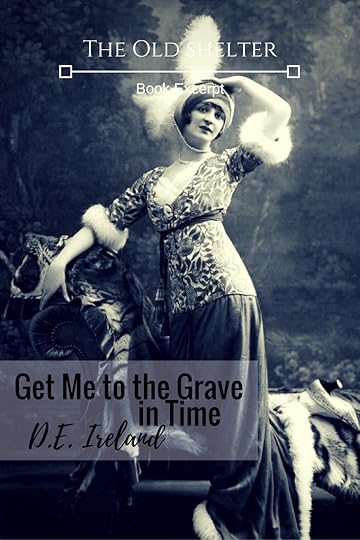
The post Thursday Quotables – Get Me to the Grave in Time appeared first on The Old Shelter.
January 6, 2017
Gang Roundup – January 2017
Here we are, the first post of the year and it’s going to be a collection.
You know, I’m still going to figure out what I’ll write for this blog this year. I do have a few posts already in mind, and I’ve kind of decided the theme for the April AtoZ Challenge will be ‘noir’. All the rest is still pretty much black.
So, I may just as well ask you what you’d like to see. Do tell me!
 1920s Cocktails
1920s CocktailsSince we’re still in a festive mood (it’s the Epiphany today, it’s bank holiday here in Italy) I figured the way to stort off is by sharing some good, Prohibition-inspired cocktail recipes.
Now I have to confess I may not be a teetotal, but I’m very closed to it, still I find the culture of cocktails so fashinating. In the early stages of my reserach for Ghost Trilogy I spen quite some energy and time researching liquors and cocktails. I don’t know, it’s fun.
So her eit is a nice collection of Prohibition cocktail to try. Well, if you have a taste for it, go aheand and make some. And dont forget to tell me how it turned out.
Dieselpunk Lexicon Part 7: Dark Cabaret
“Dark cabaret may be a simple description of the theme and mood of a cabaret performance, but more recently has come to define a particular musical genre which draws on the aesthetics of the decadent, risqué German Weimar-era cabarets, burlesque and vaudeville shows with the stylings of post-1970s goth and punk music.”
Post WW Europe (both the first and the second) is very popular in Dieselpunk literature. I’ve read quite a few short story set in Europe after WWI. There is indeed a particular feel to it which goes well with the dark, disinlusioned element of Dieselpunk and of course there’s the attitude toward totalitarism, which I suppose Europe at that time is particularly apt at portraying.
Weimar Republic Kabaret is a good synthesis of it: cutting edge, expressionist, eccessive, decadent, but also intimately vibrat. It’s a place where stories are born.
 What’s On Your Radio?
What’s On Your Radio?Radio was just starting to become popular in the 1920s and by the end of the decad it had turned into a powerful media. Some historians theorise that the success of jazz on a national level was partly possible because of the radio (and because of the pioneering recording industry, of course). Like cinema, radio offering was often national and this helped to create a national feeling for the new world.
This article gathers a bunch of early mystery radio serials (yes, there are links where you can actually listen to those serials), with a commentary on each one of them.
Really really intersting.
100 Iconic Photos of New Orleans Through the Ages
You may know by now that I love vintage photos, so it shouldn’t be a surprise this awesome collection of photoes spanning many decades of New Orleans history caught my interest. Really, go have a look at it.
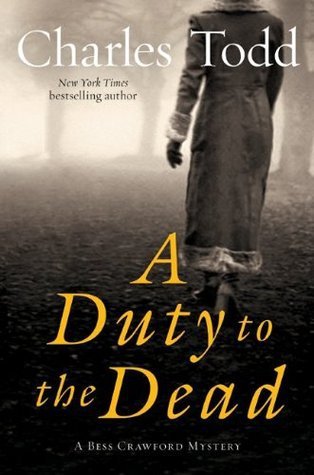 A duty to the Dead
A duty to the DeadDedicated to helping the many wounded during the Great War, Bess Crawford receives a desperate request from a dying lieutenant while serving as a nurse aboard a hospital ship. “Tell my brother Jonathan that I lied,” the young man says. “I did it for Mother’s sake. But it has to be set right.”
Back home in England, Bess receives an unexpected response from the dead soldier’s family, for neither Jonathan Graham‚ his mother‚ nor his younger brother admit to understanding what the message means.
But the Grahams are harboring a grim secret, and Bess must, somehow, get to the bottom of it. It is her sacred duty to the dead, no matter how painful, or dangerous, that obligation might be.
I’ll be honest, I was first drawn to this book by the cover (yes, I’m that kind of reader), but the blurb is also pretty awesom. And lately, I find that I’m easily hooked by stories set during WWI
Somewhere in France – October 15, 1915
Author M.K. Todd has written a trilogy of novels set during and around WWI based on her huband’s uncle’s letter from the war. On her blog, she’s sharing some of those letters and you can read one at this link.
I find it particularly intersting, and also touching, that we have the possibility to read these fist-hand account of the war. These men and women might have gone, but their words remain to us and remind us of what shoudl never happen again.

The post Gang Roundup – January 2017 appeared first on The Old Shelter.
December 31, 2016
Happy 2017!
I’ll be honest, I won’t be sorry to see 2016 go. It was a hard time on so many levels, both personal and otherwise.
But the beauty of a new beginning is that we can always wish for the best, one more time. We can still hope that things will turn to the best, at last, and we’ll have a new chance at being safe, healthy and – why not? – happy.
So I wish you all a fantastic 2017.
As for this blog, you’ll always find here more history, more music, more pictures, more 1920s. You will always be welcome in my humble internet home.
HAPPY 2017!
The post Happy 2017! appeared first on The Old Shelter.

